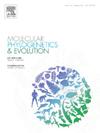Phylogenomics provides new insight into the phylogeny and diversification of Asian Lappula (Boraginaceae)
IF 3.6
1区 生物学
Q2 BIOCHEMISTRY & MOLECULAR BIOLOGY
引用次数: 0
Abstract
The application of omics data serves as a powerful tool for investigating the roles of incomplete lineage sorting (ILS) and hybridization in shaping genomic diversity, offering deeper insights into complex evolutionary processes. In this study, we utilized deep genome sequencing data from 76 individuals of Lappula and its closely allied genera, collected from China and Central Asia. By employing the HybPiper and Easy353 pipelines, we recovered 262–279 single-copy nuclear genes (SCNs) and 352–353 Angiosperms353 genes, respectively. We analyzed multiple datasets, including complete chloroplast genomes and a filtered set of 475 SCNs, to conduct phylogenetic analyses using both concatenated and coalescent-based methods. Furthermore, we employed Quartet Sampling (QS), coalescent simulations, MSCquartets, HyDe, and reticulate network analyses to investigate the sources of phylogenetic discordance. Our results confirm that Lappula is polyphyletic, with L. mogoltavica clustering with Pseudolappula sinaica and forming a sister relationship with other taxa included in this study. Additionally, three Lepechiniella taxa nested within distinct clades of Lappula. Significant gene tree discordance was observed at several nodes within Lappula. Coalescent simulations and hybrid detection analyses suggest that both ILS and hybridization contribute to these discrepancies. Flow cytometry (FCM) analyses confirmed the presence of both diploid and tetraploid taxa within Lappula. Phylogenetic network analyses further revealed that Clades IV and VII likely originated through hybridization, with the tetraploids in Clade IV arising from two independent hybridization events. Additionally, the “ghost lineage” identified as sister to Lappula redowskii serves as one of the donors in allopolyploidization. In conclusion, our study provides new insights into the deep phylogenetic relationships of Asian Lappula and its closely allied genera, contributing to a more comprehensive understanding of the evolution and diversification of Lappula.

系统基因组学为亚洲拉普拉(Boraginaceae)的系统发育和多样性提供了新的认识。
组学数据的应用是研究不完全谱系分类(ILS)和杂交在塑造基因组多样性中的作用的有力工具,为复杂的进化过程提供了更深入的见解。在这项研究中,我们利用了来自中国和中亚的76个拉普拉及其近缘属的深度基因组测序数据。利用HybPiper和Easy353管道,我们分别获得262-279个单拷贝核基因(SCNs)和352-353个被子植物353基因。我们分析了多个数据集,包括完整的叶绿体基因组和过滤后的475个scn,使用串联和聚结的方法进行系统发育分析。此外,我们采用了四重奏抽样(QS)、聚结模拟、MSCquartets、HyDe和网状网络分析来研究系统发育不一致的来源。我们的结果证实了拉普拉属具有多系性,L. mogoltavica与Pseudolappula sinaica聚类,并与本研究中的其他类群形成姐妹关系。此外,三个Lepechiniella分类群在不同的Lappula分支中筑巢。在拉普拉的几个节点上观察到显著的基因树不一致。聚结模拟和杂交检测分析表明,ILS和杂交都有助于这些差异。流式细胞术(FCM)分析证实在拉普拉属中存在二倍体和四倍体分类群。系统发育网络分析进一步表明,进化枝IV和进化枝VII可能是通过杂交产生的,进化枝IV中的四倍体是由两个独立的杂交事件产生的。此外,被认定为Lappula redowski姐妹的“幽灵血统”是异源多倍体的供体之一。总之,本研究对亚洲拉普拉及其近缘属的深层系统发育关系提供了新的认识,有助于更全面地了解拉普拉的进化和多样化。
本文章由计算机程序翻译,如有差异,请以英文原文为准。
求助全文
约1分钟内获得全文
求助全文
来源期刊
CiteScore
7.50
自引率
7.30%
发文量
249
审稿时长
7.5 months
期刊介绍:
Molecular Phylogenetics and Evolution is dedicated to bringing Darwin''s dream within grasp - to "have fairly true genealogical trees of each great kingdom of Nature." The journal provides a forum for molecular studies that advance our understanding of phylogeny and evolution, further the development of phylogenetically more accurate taxonomic classifications, and ultimately bring a unified classification for all the ramifying lines of life. Phylogeographic studies will be considered for publication if they offer EXCEPTIONAL theoretical or empirical advances.

 求助内容:
求助内容: 应助结果提醒方式:
应助结果提醒方式:


